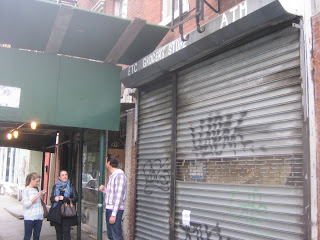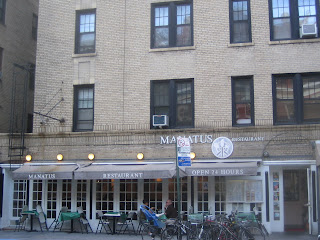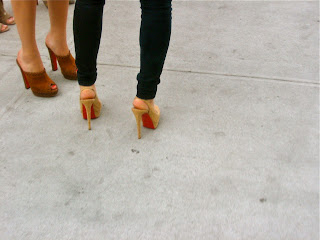Now that 51 Astor is getting
prepped for demolition, with its
tall trees chopped down, so a new glass tower can rise on its site, let's take a look at its role in the battle for Astor Place--and Cooper Union's role in it all.

The City's Department of Transportation and Cooper Union are unfolding their plan to turn Astor Place into what they call a public park, but what is clearly an amenity for more condo and office towers, setting the stage for further upscaling of the East Village and Bowery. In the plan, there will no more street called Astor Place.
Preservationists, like GVSHP,
oppose the plan because Astor Place, the street, is very old, dating back to a Native American trail from the 1600s. That's a good reason. Another good reason is that the city should not be taking away our streets to give green plazas to private developments and calling them public parks.
This isn't the first time powerful forces have tried to erase Astor Place as it stands.
Cooper Union pushed the effort back in 2001, and early reports connected the restructuring of Astor with the development of what became Gwathmey's undulating condo tower there. Somehow, in more recent reports of the
grand plan, what began as a private interest has been repositioned as a purely public work.

Let's go back a decade ago. The
New York Times reported on the neighborhood response when Cooper Union "put forth an ambitious and controversial plan...that would
radically alter a main gateway to the neighborhood. The plan includes eliminating some streets, enlarging a public park and rezoning the area to permit two new structures." Said a neighborhood activist at the time, "
Cooper Union is engaging in a real estate shell game in which the East Village will be the loser.''
J.A. Lobbia at
The Village Voice wrote in 2001, "
What Cooper Union wants is a major redevelopment that will replace low buildings with taller ones, expand a park, encroach on two city streets, alter traffic, and, along the way, disturb a literal rat's nest."
A major piece of Cooper Union's upscaling plan included leasing their
Astor Place parking lot to hotelier Ian Schrager. Wrote Lobbia in that 2001
Voice article: "the city is considering revamping Astor Place, possibly removing traffic lanes to
form a plaza joining the hotel to the Cube sculpture."
Jim Knipfel reported in the
NY Press in 2001, "Some reports also claim that
the hotel will simply envelop and 'de-map' Astor Place itself, though Cooper Union officials deny this." The opposition, he wrote, worried that "it’s one more step toward
strangling the very nature of the East Village."

In 2002,
the city approved Cooper Union's new building plans, including the hotel. At the time, the school's president promised "a set of design constraints to fit the neighborhood."
The hotel eventually evolved into the Gwathmey condo tower. In 2005 Paul Goldberger in
The New Yorker called it the "Green Monster," saying, "
it doesn’t belong in the neighborhood." It was the first of the big shiny beasts to take the East Village, arguably
paving the way for more out-of-scale buildings like the Cooper Square Hotel.
From Cooper Union, we not only got the Green Monster, but also the outsized
hive building, and soon Astor Place will have that
new office tower--several stories of gleaming glass box made to house "
high-tech companies, investment banks, insurance and advertising firms."
Cooper Union is no stranger to de-mapping, either. In the set of plans to build up Astor Place, the school asked the city to
de-map Taras Shevchenko Place, which now runs behind their silver hive building. Local Ukrainians fought back against that plan, but
what do we make of the second-naming of Shevchenko Place with Hall Place? Known as Hall since the early 1800s, it was renamed Shevchenko in 1978, but the Hall sign suddenly appeared in the fall of 2010. Is Shevchenko on the way out?

As for all that innocent, unassailable greenery, earlier this year, the City released a handbook for "High-Performance" landscaping of the city. Katharine Jose at
Capital NY called it "a window into the brain-center of Bloomberg's New York." She wonders if Bloomberg is "running the city, or using the law to influence the private decisions of New Yorkers, especially its wealthiest class, to execute the Bloomberg program?"
The redesign of Astor Place looks a lot like part of the Bloomberg program to remake the East Village into a haven for the upper classes and safety-seeking suburbanites.
When considering what's about to happen to Astor Place, we must look beyond the pretty green trees to the motivations behind the plan. Why is it really being done and for whom? Who will benefit the most from it? What will the East Village lose in the long run?
East Villagers
fought the plan in 2001, saying they "
might as well live in Midtown if Cooper Union has its way." They
fought it in 2002, worried that "the large-scale development would turn their eclectic, artistic neighborhood into a sterile business campus."
In the bike lane-loving, eco-friendly, ultra-green New York of 2011, where has that fighting spirit gone? It's as if the sight of lush greenery has wiped out our ability to think critically about this. As in the architect's renderings,
we will be nothing but ghosts, haunting the granite slabs of a suburban-style office park.

I'll end with some words by William H. Whyte, Jr., from his 1958 book
The Exploding Metropolis:
"Everybody, it would seem, is for the rebuilding of our cities... But this is not the same as
liking cities...most of the rebuilding under way and in prospect is being designed by people who don’t like cities."
"what is the image of the city of the future? In the plans for the huge redevelopment projects to come,
we are being shown a new image of the city—and it is sterile and lifeless. Gone are the dirt and the noise—and the variety and the excitement and the spirit. That it is an ideal makes it all the worse; these bleak new utopias are not bleak because they have to be; they are the concrete manifestation—and how literally—of a deep, and at times arrogant, misunderstanding of the function of the city."


























































